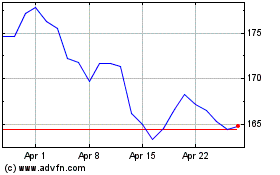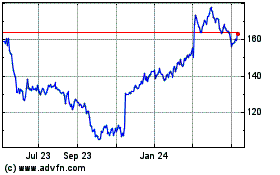By Heather Haddon
Grocers are struggling to lure e-commerce-loving millennials
into their aisles amid what experts say is a permanent shift in
shopping patterns among consumers.
Baby boomers used to bring long grocery lists to supermarkets
and club stores. Now shoppers in their 20s and 30s are visiting
supermarkets less frequently than their parents, government records
and survey data show. They are spreading purchases across new
options, including online grocery services such as AmazonFresh,
beefed-up convenience stores and stronger food offerings from
omnibus retailers like Wal-Mart Stores Inc. and Target Corp.
"I don't think we've seen shopping change so dramatically ever,"
said Marty Siewert, senior vice president for consumer and shopper
analytics at Nielsen. "Those things in the past that have been real
drivers for grocery in terms of freshness and quality aren't the
key drivers for millennials."
Consumers between 25 and 34 years of age last year spent an
average of $3,539 on groceries, about $1,000 less in
inflation-adjusted dollars than people that age spent in 1990,
federal data shows.
On average, consumers overall bought $4,015 in food for their
homes last year.
The shift away from big grocery bills wasn't as obvious before
the financial crisis saddled millennials with student debt and weak
job prospects, and placed a lasting drag on consumer spending.
Sales at food and beverage retailers rose 3.7% between 2002 and
2007, an analysis of U.S. Census figures by A.T. Kearney shows,
while they grew just 2.4% annually from 2008 to 2013.
Alexis Tyler, a 19-year-old college student in Creston, Iowa,
who buys food at Wal-Mart and discount grocer H-E-B, worries about
paying off her student loans after graduation. "I only buy ground
beef and chicken breast and pre-sliced ham for sandwiches," Ms.
Tyler said.
The more than 75 million Americans born in the 1980s and 1990s
are also delaying marriage and childbearing, milestones that
traditionally lead people to start making big trips to the grocery
store.
Aging baby boomers also cut back on grocery-store spending,
federal data shows. That is coming during one of the worst slumps
in years for food retailers, especially those most dependent on
brick-and-mortar stores.
Burt Weiss, a baby boomer from St. Louis, said he's slashed
thousands of dollars of his grocery bills in his later years by
scouting for sales, shopping discount retailers like Aldi and
hitting convenience stores on occasion for food. "The object is to
eat well for as little as possible, " Mr. Weiss said. His grown
sons, in contrast, tend to go out to dine more.
A slump in prices for staples like meat and eggs has also
sparked a margin-erasing price war among supermarkets that, in some
cases, overexpanded during the boom times. Average prices for key
staples have declined year-over-year for 10 straight months, a
slump last topped back in 1960, federal data shows.
There were 1.4 million restaurants and grocery stores in the
U.S. last year, up from half a million in 1985. Wal-Mart, the
nation's largest food seller, added more grocery-selling outlets in
the last decade than any company, more than doubling its total to
4,645, according to industry data from the company and Progressive
Grocer. Discount outlets multiplied as well. Dollar and convenience
stores accounted for 81% of the 6,588 food retailers that opened
between 2013 and 2015, Nielsen TDLinx figures show.
Some supermarkets and food retailers have been forced to merge,
close stores or cancel expansions. Wal-Mart closed 154 U.S. stores
earlier this year, and plans to add only 55 new outlets in its new
fiscal year. Executives at Wal-Mart say the shift, their slowest
expansion in decades, will allow them to prioritize e-commerce
investments.
To win over the key young consumer group, some supermarkets are
testing smartphone apps that customers can use to place their
orders in advance, and introducing new product lines. Grocers are
joining with third-party services such as Instacart Inc., Shipt and
UberRush to reclaim millennials before they drift further to
Amazon.com Inc. or other delivery services such as FreshDirect.
This fall, Walker, Mich.-based Meijer Inc. joined with Shipt to
offer one-hour grocery delivery from 25 stores for a subscription
of $99 annually. Nearly 5,000 users have signed up for the service
so far, outpacing expectations, a Meijer spokesman said.
Still, consolidation is likely to continue in food retailing
before more millennials have children and return to the grocery
store in greater numbers, said Diana Sheehan, director of retail
insights for the consulting firm Kantar.
"What they buy may change, but the value is going to come back,"
said Ms. Sheehan. "It's just going to be a few years later than
expected."
--Julie Jargon contributed to this article.
Write to Heather Haddon at heather.haddon@wsj.com
(END) Dow Jones Newswires
October 27, 2016 10:52 ET (14:52 GMT)
Copyright (c) 2016 Dow Jones & Company, Inc.
Target (NYSE:TGT)
Historical Stock Chart
From Mar 2024 to Apr 2024

Target (NYSE:TGT)
Historical Stock Chart
From Apr 2023 to Apr 2024
